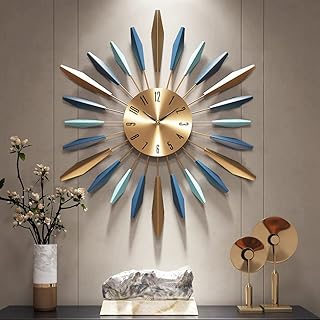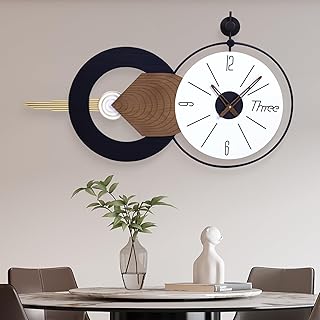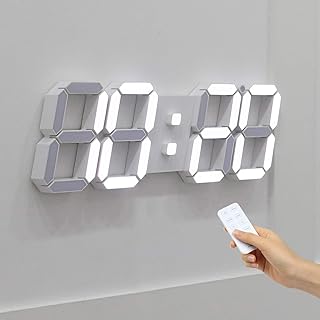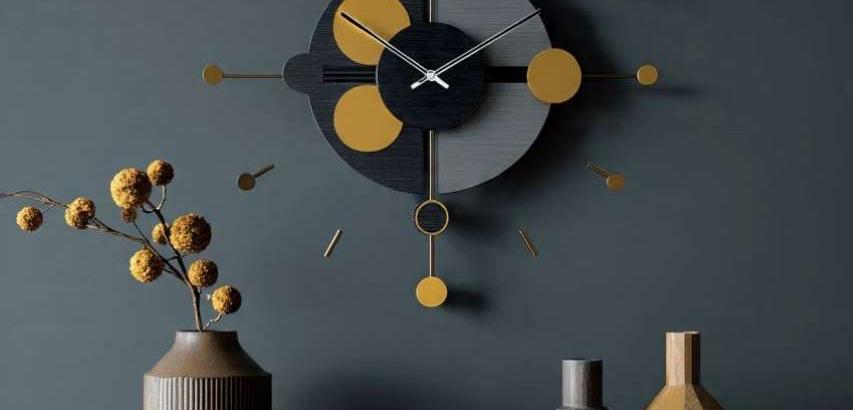Modern Wall Clocks are more than just time-telling devices; they are definitive statements of interior design, blending art, technology, and functionality. They have evolved from their traditional, purely utilitarian ancestors into sculptural pieces that reflect personal style, enhance a room's aesthetic, and often incorporate advanced technology.
Defining Characteristics of Modern Wall Clocks
The "modern" label encompasses several design movements, including Mid-Century Modern, Minimalist, Industrial, and Scandinavian. Their core characteristics include:
Clean Lines and Simplicity: A rejection of ornate details in favor of geometric shapes, uncluttered faces, and a focus on form.
Minimalist Dials: Often feature pared-down numerals (e.g., simple stick markers, dots) or no numerals at all (numberless dials). This creates a sleek, sophisticated look.
Innovative Use of Materials: Moves beyond wood and plastic to include metal (brushed, matte black, or polished), acrylic/glass, concrete, marble, and even sustainable materials like bamboo or reclaimed wood.
Neutral and Monochromatic Palettes: Heavy use of black, white, gray, and natural tones. Pops of color are often used strategically rather than as a primary feature.
Form as the Focal Point: The clock's design, silhouette, or unique mechanism is often the centerpiece, making it a conversation starter.
Key Categories and Types
Minimalist Clocks:
Focus: The essence of "less is more." They prioritize legibility and calm.
Features: Thin hands, sparse or absent markers, and a neutral color scheme. The goal is to blend seamlessly into a space without overwhelming it.
Mid-Century Modern Clocks:
Focus: A retro-futuristic aesthetic from the 1950s and 60s.
Features: Organic shapes (sunbursts, starbursts), teak wood, bold colors (mustard yellow, olive green), and sputnik-style designs with protruding rods.
Industrial Clocks:
Focus: Raw, utilitarian, and inspired by factories and warehouses.
Features: Exposed mechanisms (skeleton clocks), metal cages, distressed finishes, weathered wood, and large, easy-to-read numerals.
Scandinavian Clocks:
Focus: Hygge and functionalism. They are warm, simple, and inviting.
Features: Light wood tones (like pine or birch), simple geometric forms, and a touch of playful elegance.
Abstract and Sculptural Clocks:
Focus: The clock as an art piece.
Features: Unconventional forms where the time-telling function is almost secondary. This includes clocks with floating hands, deconstructed elements, or unique spatial designs.
Smart and Digital Modern Clocks:
Focus: Integrating technology seamlessly into home decor.
Features:
Wi-Fi/Atomic Clocks: Automatically sync to atomic time signals for perfect accuracy.
Smart Displays: Clocks like the Google Nest Hub or Amazon Echo Show that provide time, weather, calendar, and smart home control.
LED and Flip Clocks: Offer a retro-digital vibe with modern reliability.
Movement Types: The Heart of the Clock
Quartz Movement: The most common. Powered by a battery, they are highly accurate, affordable, and low-maintenance. The battery sends an electrical signal through a quartz crystal, causing it to vibrate at a precise frequency and move the hands.
Mechanical Movement: A hallmark of high-end, designer clocks. Requires manual winding. Prized for its craftsmanship, intricate visible mechanics, and the absence of a battery.
Smart Movement: Connects to your home Wi-Fi. Offers features like automatic timezone adjustment, integration with smart home systems, and sometimes even silent movement.
Materials and Craftsmanship
Metals: Brushed brass, matte black steel, and polished chrome are popular for their durability and sleek look.
Wood: From rich walnut in Mid-Century designs to light oak in Scandinavian styles, wood adds warmth and texture.
Acrylic and Glass: Used for transparent or floating designs, creating a sense of lightness and modernity.
Concrete and Stone: Provides an ultra-modern, industrial, or brutalist feel, emphasizing raw texture and weight.
Sustainable Materials: Reflecting an eco-conscious ethos, using bamboo, cork, or recycled materials.
Advantages and Design Benefits
Aesthetic Enhancement: Serves as a key decorative element that can tie a room's design theme together or act as a standalone focal point.
Space Definition: A large, modern clock can help define a living area or anchor a wall in an open-plan space.
Improved Ambiance: Unlike constantly checking a phone, a wall clock provides a gentle, non-intrusive way to keep track of time, reducing screen time.
Quiet Operation: High-quality modern clocks, especially smart ones with silent sweeps, operate without the distracting ticking sound of traditional clocks.
Considerations When Choosing a Modern Wall Clock
Scale and Proportion: The clock should be appropriately sized for the wall and the room. A common mistake is choosing a clock that is too small.
Legibility: Ensure the time is easy to read from a distance, especially with minimalist or abstract designs.
Placement: Hang the clock at eye level in the room's primary sightline. Consider the relationship with other wall art and furniture.
Lighting: Some clocks have no illumination, making them difficult to read at night. Consider this if nighttime visibility is important.
Movement Quality: A high-quality quartz or mechanical movement ensures accuracy and longevity, preventing the frustration of a constantly inaccurate clock.
The Modern Wall Clock has successfully transcended its basic function to become an essential tool of interior design. It is a reflection of personal taste, whether that leans towards the serene simplicity of minimalism, the warm nostalgia of mid-century design, or the cutting-edge integration of smart technology. By carefully selecting a modern wall clock, you are not just choosing a way to tell time—you are choosing a piece of art that enhances your daily living environment and makes a definitive statement about your style.
 |  |  |
 |  |  |
